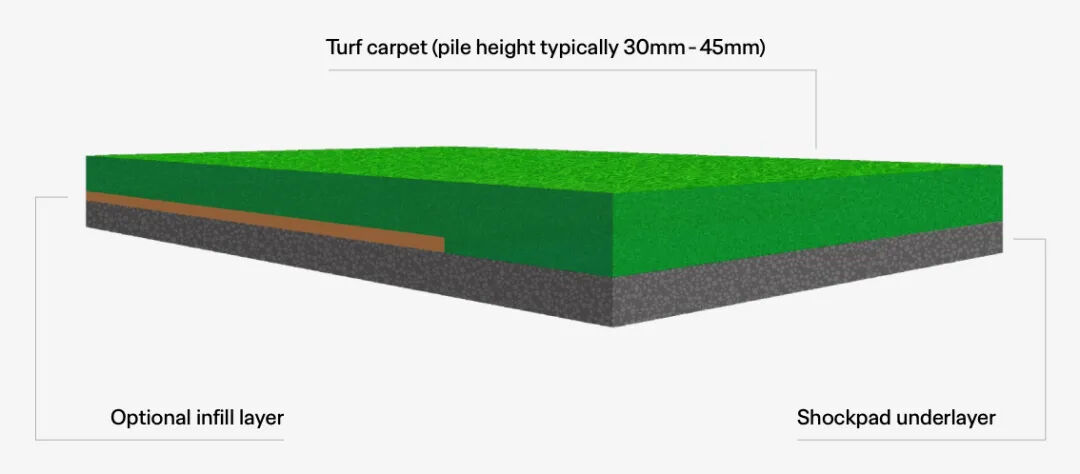FIFA and FIH jointly issued guidelines for multi-functional sports artificial grass facilities
In the construction of modern sports facilities, multi-functional sports venues are becoming a development trend. Traditional single-purpose venues are difficult to meet the demand for venue utilization rate at the grassroots level. Shock-absorbing pads are often laid under the lawn, and they can be laid in three ways: rolls, blocks, and on-site mixed laying. When choosing a lawn, it is necessary to ensure that it has the characteristics of competition, provides protection and comfort for athletes, and can withstand frequent use and bad weather. Before artificial turf is launched on the market, its quality needs to be verified through laboratory tests to avoid improper product selection and ensure it reaches the expected service life.
According to this guideline, football prefers longer grass filaments (usually 35-50 millimeters) to simulate the effect of natural grass fields, while hockey is more suitable for shorter grass filaments (20-30 millimeters) to ensure the speed and trajectory stability of the ball. To balance the demands of both, it is recommended to use medium-length grass filaments of 30-45 millimeters and adopt a high-density tufting process to prevent the hockey stick from getting stuck in the gaps between the grass filaments. In terms of the selection of filling materials, the specification suggests using environmentally friendly fillers or adopting partial filling schemes.

The standard lawn structure of a football field/hockey field
This guideline elaborates in detail on the key performance indicators and quality standards of dual-purpose artificial turf fields in football and hockey. The following are some indicators:
Performance standards: For the two types of sports, the guidelines stipulate specific performance requirements for the venue in terms of ball rebound, roll, and roll deviation, etc. For example, the selectable range of the football's rebound is from 60 centimeters to 115 centimeters.
Quality standards: The guideline sets out strict quality requirements for the materials used in the construction of dual-purpose sites. In terms of filling materials, the guideline clearly stipulates that the total content of eight polycyclic aromatic hydrocarbons (PAHs) shall not exceed 20 mg/kg to ensure the health and safety of athletes.
Durability: The guideline emphasizes the durability of the site and sets out specific requirements for the tensile strength of the turf system, such as: for monofilaments and net filaments with a fineness of less than or equal to 1200 dtex: their tensile strength must be ≥5N; For monofilaments and meshes with a fineness greater than or equal to 1200 dtex, their tensile strength must be ≥8N.
Surface flatness: The guideline stipulates that when the surface of the playing field is tested with a 3-meter straightedge, the deviation should not exceed 6 millimeters. The testing method follows the FIFA TM 08 standard.
Water permeability: The guideline requires that the site should have good drainage performance, and the water permeability should reach ≥150 millimeters per hour. The test method follows the EN 12616 standard.
Tufting pulping force: The guideline also sets requirements for the pulping force of grass fibers, which should reach ≥40 Newtons to ensure that the grass fibers are not easily pulled out and to guarantee the service life of the site. The test method follows the standard of Method 2 of EN 12228 or EN13744.
Shock-absorbing pads: The guidelines require that the shock-absorbing pads used must comply with the European standard EN 15330-4 to effectively absorb shock and protect the safety of athletes.
Venue Certification: The guide also introduces the certification process and standards for dual-use venues to ensure that the venues comply with the relevant requirements of FIH and FIFA.
At present, this guideline has been released globally through the official websites of the two major organizations, FIH and FIFA, and is available in English, French and Spanish. Industry experts point out that the implementation of this innovative standard will significantly reduce the construction cost of community sports facilities, improve the efficiency of venue utilization, and is particularly helpful for promoting football and hockey in developing countries. In the future, venues that meet this standard can apply for dual certification, providing convenient conditions for hosting two types of events.
The launch of this new dual-purpose artificial turf guideline not only resolves the long-standing technical challenge of compatibility between football and hockey fields, but also provides a standardized solution for the sharing of fields in other sports, marking a milestone in promoting the construction of grassroots sports facilities worldwide.


